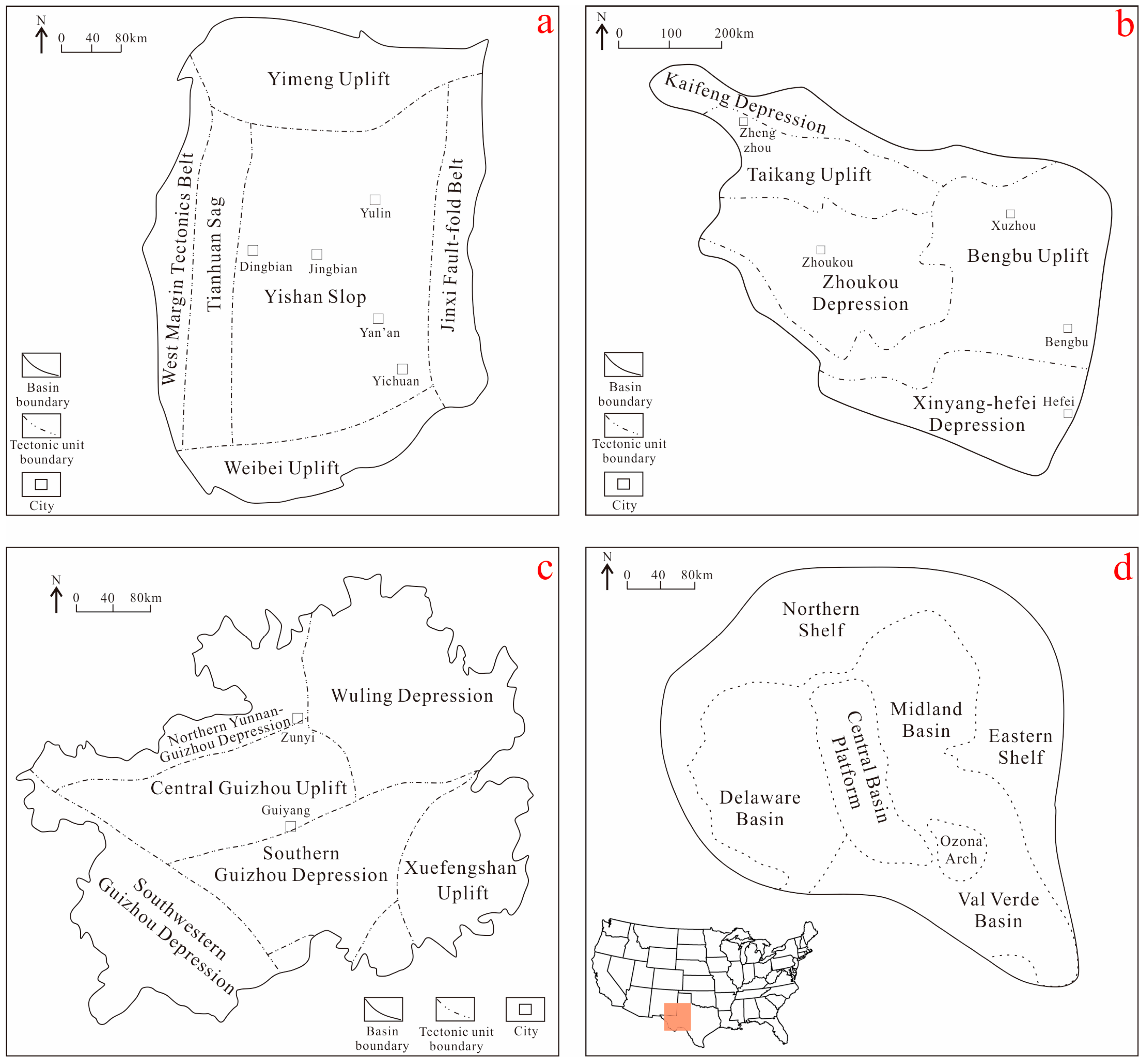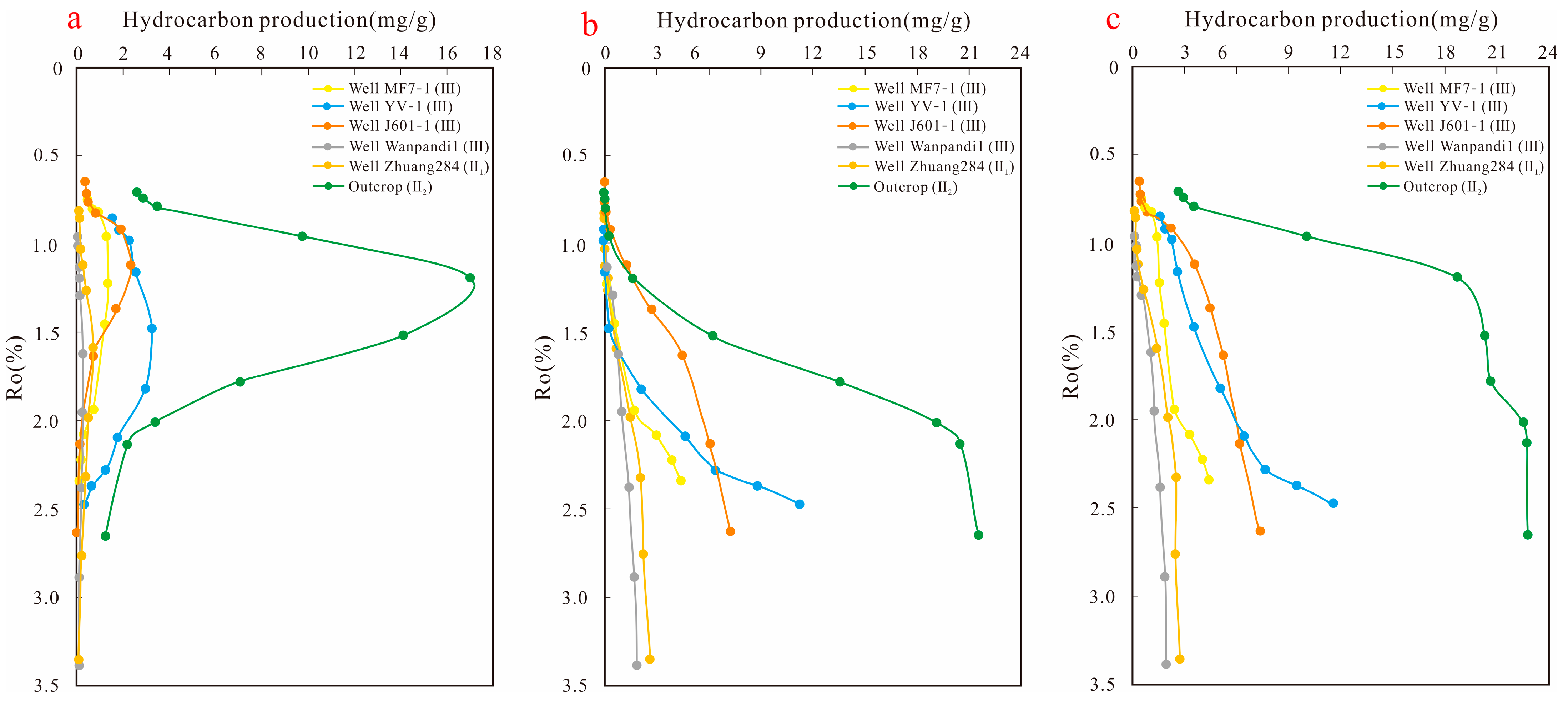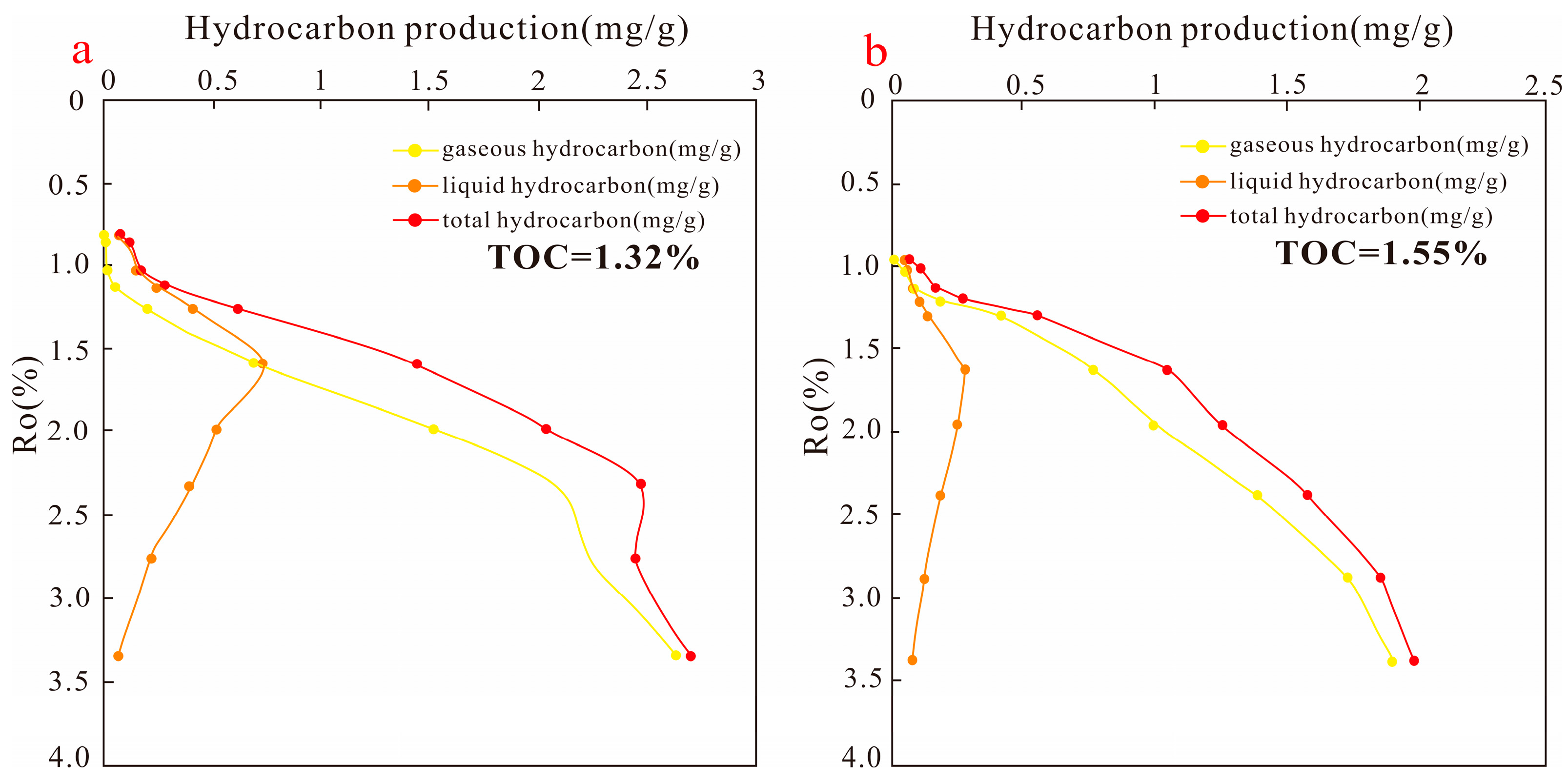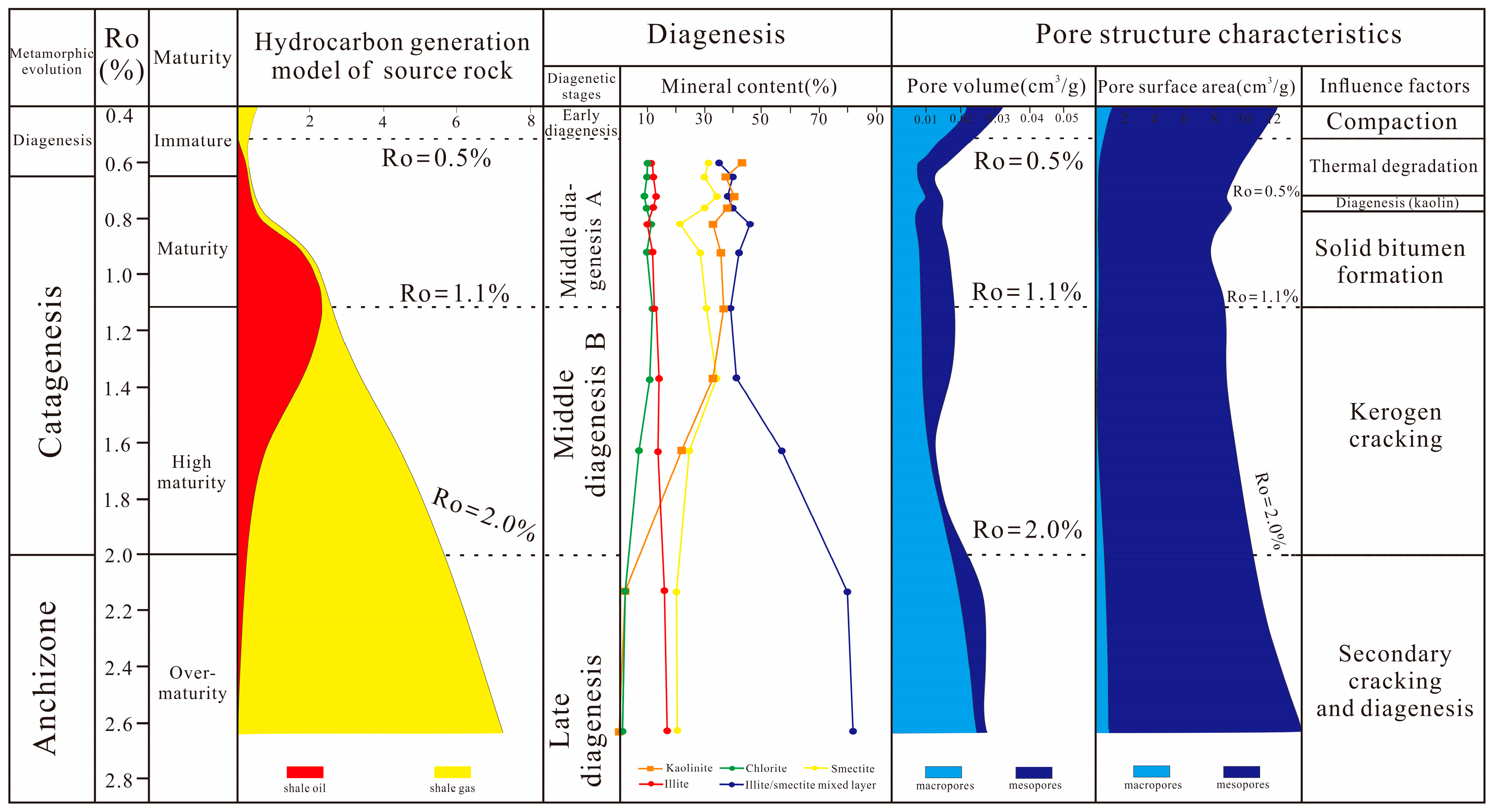New Advance in the Study of Shale Oil Generation Peak Determination and Diagenetic Pore Evolution
Abstract
1. Introduction
2. Geological Setting
3. Materials and Methods
3.1. Materials
3.2. Methods
3.2.1. Thermal Simulation Experiment
3.2.2. Reflectance Experiment (Ro)
3.2.3. Adsorption and Mercury Porosimetry Experiment
3.2.4. X-ray Diffraction Analysis
3.2.5. TOC Content Test
4. Results
4.1. Hydrocarbon Generation Product Characteristics
4.1.1. Liquid Hydrocarbon Yield Characteristics
4.1.2. Gaseous Hydrocarbon Yield Characteristics
4.1.3. Total Hydrocarbon Yield Characteristics
4.2. Clay Minerals’ Composition Characteristics
4.3. Pore Evolution Characteristics
5. Discussion
5.1. Determine Peak Oil Generation
5.2. TOC Content and Shale Hydrocarbon Generation
5.3. Diagenetic Stage and Pore Evolution of Shale
6. Conclusions
Author Contributions
Funding
Data Availability Statement
Acknowledgments
Conflicts of Interest
References
- Zou, C.N. Shale Oil and Gas. In Unconventional Petroleum Geology, 2nd ed.; Elsevier: Amsterdam, The Netherlands, 2017; pp. 275–321. [Google Scholar] [CrossRef]
- Zou, C.N.; Zhao, Q.; Dong, D.Z.; Yang, Z.; Qiu, Z.; Liang, F.; Wang, N.; Huang, Y.; Duan, A.X.; Zhang, Q.; et al. Geological characteristics, main challenges and future prospect of shale gas. J. Nat. Gas Geosci. 2017, 2, 273–288. [Google Scholar] [CrossRef]
- Soeder, D.J. The successful development of gas and oil resources from shales in North America. J. Petrol. Sci. Eng. 2018, 163, 399–420. [Google Scholar] [CrossRef]
- Goodarzi, F.; Hosseininejad, S.; Pedersen, P.K.; Gentzis, T.; Sanei, H. Characterization of immature oil shales from the Cretaceous Second White Specks Formation in Saskatchewan and Manitoba, Canada. Mar. Pet. Geol. 2022, 143, 105774. [Google Scholar] [CrossRef]
- Sohail, G.M.; Radwan, A.E.; Mahmoud, M. A review of Pakistani shales for shale gas exploration and comparison to North American shale plays. Energy Rep. 2022, 8, 6423–6442. [Google Scholar] [CrossRef]
- Ma, Y.S.; Cai, X.Y.; Zhao, P.R. China’s shale gas exploration and development: Understanding and practice. Pet. Explor. Dev. 2018, 45, 589–603. [Google Scholar] [CrossRef]
- Wang, R.Y.; Wang, G.P.; Zhao, G.; Qian, M.H.; Liu, Y.J.; He, W.L.; Li, Z.H. Geological characteristics and resources potential of shale oil in Chang7 Member of Upper Triassic Yanchang Formation in Fuxian area, southern Ordos Basin, western China. Unconv. Resour. 2023, 3, 237–247. [Google Scholar] [CrossRef]
- Zou, C.N.; Yang, Z.; Cui, J.W.; Zhu, R.K.; Hou, L.H.; Tao, S.Z.; Yuan, X.J.; Wu, S.T.; Lin, S.H.; Wang, L.; et al. Formation mechanism, geological characteristics and development strategy of nonmarine shale oil in China. Pet. Explor. Dev. 2013, 40, 15–27. [Google Scholar] [CrossRef]
- Jiang, F.J.; Hu, M.L.; Hu, T.; Lyu, J.H.; Huang, L.L.; Liu, C.L.; Jiang, Z.X.; Huang, R.D.; Zhang, C.X.; Wu, G.Y.; et al. Controlling factors and models of shale oil enrichment in Lower Permian Fengcheng Formation, Mahu Sag, Junggar Basin, NW China. Pet. Explor. Dev. 2023, 50, 812–825. [Google Scholar] [CrossRef]
- Gentzis, T. A review of the thermal maturity and hydrocarbon potential of the Mancos and Lewis shales in parts of New Mexico, USA. Int. J. Coal Geol. 2013, 113, 64–75. [Google Scholar] [CrossRef]
- Gentzis, T. Review of the hydrocarbon potential of the Steele Shale and Niobrara Formation in Wyoming, USA: A major unconventional resource play? Int. J. Coal Geol. 2016, 166, 118–127. [Google Scholar] [CrossRef]
- Guo, S.B.; Mao, W.J. Division of diagenesis and pore evolution of a Permian Shanxi shale in the Ordos Basin, China. J. Petrol. Sci. Eng. 2019, 182, 106351. [Google Scholar] [CrossRef]
- He, Q.B.; Chen, S.J.; Li, S.X.; Guo, B.Z.; Lu, J.G.; Li, Y.; Li, X.G.; Zhao, L.P.; Ma, Z.W. Organic geochemical characteristics and hydrocarbon generation mechanism of marine-continental transitional organic-rich shale: A case study from the Shanxi formation in the eastern margin of the Ordos Basin. J. Petrol. Sci. Eng. 2022, 219, 111116. [Google Scholar] [CrossRef]
- Li, K.; Cheng, Y.; Su, L.; Zhang, T.Y.; Tang, G.M.; He, J.H.; Wang, H.D. Experiment on hydrocarbon generation characteristics of lacustrine mudstone in third member of Dongying Formation, Bohai Oilfield, Bohai Bay Basin. Nat. Gas Geosci. 2023, 34, 2210–2221, (In Chinese with English Abstract). [Google Scholar] [CrossRef]
- Li, G.X.; Zhang, B.; Wu, K.Y.; Wu, S.T.; Wang, X.M.; Zhang, J.; Qi, X.N.; Zhang, N.; Xing, H.T.; Xian, C.G.; et al. Low organic matter abundance and highly efficient hydrocarbon generation of saline source rock in the Qaidam Basin, NW China. Pet. Explor. Dev. 2023, 50, 898–910. [Google Scholar] [CrossRef]
- Xu, L.W.; Yang, K.J.; Wei, H.; Liu, L.F.; Jiang, Z.X.; Li, X.; Chen, L.; Xu, T.; Wang, X.M. Pore evolution model and diagenetic evolution sequence of the Mesoproterozoic Xiamaling shale in Zhangjiakou, Hebei. J. Petrol. Sci. Eng. 2021, 207, 109115. [Google Scholar] [CrossRef]
- Hu, C.E.; Tan, J.Q.; Lyu, Q.; Zhang, Y.L. Evolution of organic pores in Permian low maturity shales from the Dalong Formation in the Sichuan Basin: Insights from a thermal simulation experiment. Gas Sci. Eng. 2024, 121, 205166. [Google Scholar] [CrossRef]
- Teng, J.; Qiu, L.W.; Zhang, S.P.; Ma, C.F. Origin and diagenetic evolution of dolomites in Paleogene Shahejie Formation lacustrine organic shale of Jiyang Depression, Bohai Bay Basin, East China. Pet. Explor. Dev. 2022, 49, 1251–1265. [Google Scholar] [CrossRef]
- Wang, X.; Wang, M.; Li, J.B.; Shao, H.M.; Deng, Z.X.; Wu, Y. Thermal maturity: The controlling factor of wettability, pore structure, and oil content in the lacustrine Qingshankou shale, Songliao Basin. J. Petrol. Sci. Eng. 2022, 215, 110618. [Google Scholar] [CrossRef]
- Zhang, L.F.; Dong, D.Z.; Qiu, Z.; Wu, C.J.; Zhang, Q.; Wang, Y.M.; Liu, D.X.; Deng, Z.; Zhou, S.W.; Pan, S.Q. Sedimentology and geochemistry of Carboniferous-Permian marine-continental transitional shales in the eastern Ordos Basin, North China. Palaeogeogr. Palaeoclimatol. Palaeoecol. 2021, 571, 110389. [Google Scholar] [CrossRef]
- Zhao, B.S.; Li, R.X.; Qin, X.L.; Wang, N.; Zhou, W.; Khaled, A.; Zhao, D.; Zhang, Y.N.; Wu, X.L.; Liu, Q. Geochemical characteristics and mechanism of organic matter accumulation of marine-continental transitional shale of the lower permian Shanxi Formation, southeastern Ordos Basin, north China. J. Petrol. Sci. Eng. 2021, 205, 108815. [Google Scholar] [CrossRef]
- Qiu, Z.; Song, D.J.; Zhang, L.F.; Zhang, Q.; Zhao, Q.; Wang, Y.M.; Liu, H.L.; Liu, D.X.; Li, S.X.; Li, X.T. The geochemical and pore characteristics of a typical marine–continental transitional gas shale: A case study of the Permian Shanxi Formation on the eastern margin of the Ordos Basin. Energy Rep. 2021, 7, 3726–3736. [Google Scholar] [CrossRef]
- Guo, S.B.; Zheng, H.M.; Huang, J.G. Integrated Exploration Prospects of Unconventional Gas of Upper Paleozoic in Ordos Basin. Geol. Sci. Technol. Info. 2014, 33, 69–77, (In Chinese with English Abstract). [Google Scholar]
- Guo, S.B.; Peng, Y.X. Determination method of shale gas content: A case study in the Ordos Basin, China. J. Petrol. Sci. Eng. 2019, 173, 95–100. [Google Scholar] [CrossRef]
- Dou, W.T.; Hou, M.C.; Chen, H.D.; Dong, G.Y. A research on the conditions of the reservoir formation and the main controlling factors of Upper Triassic Yanchang Formation in Ordos Basin, China. J. Chengdu Univ. Technol. Sci. Technol. Ed. 2008, 35, 686–692, (In Chinese with English Abstract). [Google Scholar] [CrossRef]
- Zhang, M.Z.; Ji, L.M.; Wu, Y.D.; He, C. Palynofacies and geochemical analysis of the Triassic Yanchang Formation, Ordos Basin: Implications for hydrocarbon generation potential and the paleoenvironment of continental source rocks. Int. J. Coal Geol. 2015, 152, 159–176. [Google Scholar] [CrossRef]
- Yuan, X.J.; Lin, S.H.; Liu, Q.; Yao, J.L.; Wang, L.; Guo, H.; Deng, X.Q.; Cheng, D.W. Lacustrine fine-grained sedimentary features and organicrich shale distribution pattern: A case study of Chang7 Member of Triassic Yanchang Formation in Ordos Basin, NW China. Pet. Explor. Dev. 2015, 42, 37–47. [Google Scholar] [CrossRef]
- Er, C.; Li, Y.Y.; Zhao, J.Z.; Wang, R.; Wei, Z.K. Characteristics of lacustrine organic-rich shale: A case study of the Chang 7 member, Triassic Yanchang Formation, Ordos Basin, China. J. Nat. Gas Geosci. 2016, 1, 173–185. [Google Scholar] [CrossRef]
- Lu, H.; Li, Q.; Yue, D.L.; Wu, S.H.; Fu, Y.P.; Tang, R.Z.; Zhang, Z.Y. Study on optimal selection of porosity logging interpretation methods for Chang 73 segment of the Yanchang Formation in the southwestern Ordos Basin, China. J. Petrol. Sci. Eng. 2021, 198, 108153. [Google Scholar] [CrossRef]
- Jiang, S.; Chen, L.; Wu, Y.; Jiang, Z.L.; McKenna, E. Hybrid plays of Upper Triassic Chang7 lacustrine source rock interval of Yanchang Formation, Ordos Basin, China. J. Petrol. Sci. Eng. 2017, 159, 182–196. [Google Scholar] [CrossRef]
- Tanner, L.H.; Wang, X.; Morabito, A.C. Fossil charcoal from the Middle Jurassic of the Ordos Basin, China and its paleoatmospheric implications. Geosci. Front. 2012, 3, 493–502. [Google Scholar] [CrossRef]
- Guo, S.B. The influence of the pre-existing topography on the depositionary systems, the development of the Lower Jurassic reservoirs and hydrocarbon accumulation in Central Western Ordos Basin. J. Petrol. Sci. Eng. 2010, 75, 129–134. [Google Scholar] [CrossRef]
- Wang, D.D.; Shao, L.Y.; Li, Z.X.; Li, M.P.; Lv, D.W.; Liu, H.Y. Hydrocarbon generation characteristics, reserving performance and preservation conditions of continental coal measure shale gas: A case study of Mid-Jurassic shale gas in the Yan’an Formation, Ordos Basin. J. Petrol. Sci. Eng. 2016, 145, 609–628. [Google Scholar] [CrossRef]
- Peng, Y.X.; Guo, S.B. Lithofacies analysis and paleosedimentary evolution of Taiyuan Formation in Southern North China Basin. J. Petrol. Sci. Eng. 2023, 220, 111127. [Google Scholar] [CrossRef]
- Tang, S.; Zhang, J.C.; Elsworth, D.; Tang, X.; Li, Z.M.; Du, X.R.; Yang, X.Q. Lithofacies and pore characterization of the Lower Permian Shanxi and Taiyuan shales in the southern North China Basin. J. Nat. Gas Sci. Eng. 2016, 36, 644–661. [Google Scholar] [CrossRef]
- Sun, J.; Zheng, Q.G.; Wen, Z.H.; Hou, F.H.; Xiao, R.; Ren, J.Z. Shale gas reservoir-forming conditions and exploration prospect in Permian Shanxi Formation of the Southern North China basin. Mar. Geol. Front. 2014, 30, 20–27, (In Chinese with English Abstract). [Google Scholar] [CrossRef]
- He, Q.; Dong, T.; He, S.; Zhai, G.Y. Methane adsorption capacity of marine-continental transitional facies shales: The case study of the Upper Permian Longtan Formation, northern Guizhou Province, Southwest China. J. Petrol. Sci. Eng. 2019, 183, 106406. [Google Scholar] [CrossRef]
- Liu, S.X.; Wu, C.F.; Li, T.; Wang, H.C. Multiple geochemical proxies controlling the organic matter accumulation of the marine-continental transitional shale: A case study of the Upper Permian Longtan Formation, western Guizhou, China. J. Nat. Gas Sci. Eng. 2018, 56, 152–165. [Google Scholar] [CrossRef]
- Fan, M.J.; Alsalem, O.B.; Tian, H.; Kasprowicz, F.; Valencia, V.A. Paleozoic evolution and heterogeneity of sediment provenance in the permian basin. Palaeogeogr. Palaeoclimatol. Palaeoecol. 2022, 588, 110820. [Google Scholar] [CrossRef]
- Fairhurst, B.; Ewing, T.; Lindsay, B. West texas (permian) super basin, united states: Tectonics, structural development, sedimentation, petroleum systems, and hydrocarbon reserves. AAPG Bull. 2021, 105, 1099–1147. [Google Scholar] [CrossRef]
- Davis, A.; Kolawole, O.; Watson, M.; Onwumelu, C. Optimal field development and production design for unconventional reservoirs: A case study from central sub-basin, permian basin, new mexico. Pet. Res. 2021, 6, 66–76. [Google Scholar] [CrossRef]
- Mazzullo, S.J. Permian stratigraphy and facies, permian basin (texas-new mexico) and adjoining areas in the midcontinent united states. In The Permian of Northern Pangea; Springer: Berlin/Heidelberg, Germany, 1995; pp. 41–60. [Google Scholar] [CrossRef]
- DZ/T 0457-2023; Preparation Method for Oil Shale Sample. Ministry of Natural. Resources of the People’s Republic of China: Beijing, China, 2024.
- SY/T 5124-2012; Method of Determining Microscopically the Reflectance of Vitrinite in Sedimentary. National Energy Administration of People’s Republic of China: Beijing, China, 2013.
- NB/T 14008-2021; Analysis of Full-Scale Pore Size Distribution of Shale Method Combined by Mercury Porosimetry and Gas Adsorption. National Energy Administration of People’s Republic of China: Beijing, China, 2022.
- SY/T 5163-2018; Analysis Method for Clay Minerals and Ordinary Non-Clay Mineralsin Sedimentary Rocks by the X-ray Diffraction. National Energy Administration of People’s Republic of China: Beijing, China, 2019.
- GB/T 19145-2022; Determination for Total Organic Carbon in Sedimentary Rock. Standardization administration of the People’s Republic of China: Beijing, China, 2022.
- Tissot, B.P.; Welte, D.H. Petroleum Formation and Occurrence; Springer Science & Business Media: New York, NY, USA, 1984. [Google Scholar] [CrossRef]
- Waples, D.W. Time and temperature in petroleum formation: Application of lopatin’s method to petroleum exploration1. AAPG Bull. 1980, 64, 916–926. [Google Scholar] [CrossRef]
- Zhao, W.Z.; Hu, S.Y.; Hou, L.H.; Yang, T.; Li, X.; Guo, B.C.; Yang, Z. Types and resource potential of continental shale oil in China and its boundary with tight oil. Pet. Explor. Dev. 2020, 47, 1–11. [Google Scholar] [CrossRef]
- Hakimi, M.H.; Lashin, A.; Varfolomeev, M.A.; Rahim, A.; Sen, S.; Naseem, W.; Saeed, S.A.; Al-Muntaser, A.A.; Qadri, S.M.T.; Mustapha, K.A. Oil generation and expulsion modeling of the syn-rift Salif oil-source rock in the Tihamah Basin, Yemeni Red Sea: Implications for shale oil exploration. J. Afr. Earth Sci. 2023, 202, 104924. [Google Scholar] [CrossRef]
- Gao, D.C.; Guo, C.; Jiang, C.F.; Zhang, L.X.; Wang, H.; Shi, P.; Chen, Y.Y. Hydrocarbon generation simulation of low-maturity shale in Shanxi Formation, Ordos Basin. Pet. Geol. Expt. 2018, 40, 454–460, (In Chinese with English Abstract). [Google Scholar]
- Sun, J.; Xiao, X.M.; Cheng, P.; Wang, M.L.; Tian, H. The relationship between oil generation, expulsion and retention of lacustrine shales: Based on pyrolysis simulation experiments. J. Petrol. Sci. Eng. 2021, 196, 107625. [Google Scholar] [CrossRef]
- Liang, Z.K.; Jiang, Z.X.; Qiao, P.; Wu, W.; Jiang, Y.Q.; Tang, X.L.; Chen, R.H.; Arif, M. Molecular structure and evolution mechanism of shale kerogen: Insights from thermal simulation and spectroscopic analysis. J. Anal. Appl. Pyrolysis 2024, 181, 106648. [Google Scholar] [CrossRef]
- Hui, S.S.; Pang, X.Q.; Jiang, F.J.; Wang, C.X.; Mei, S.X.; Hu, T.; Pang, H.; Li, M.; Zhou, X.L.; Shi, K.Y. Quantitative effect of kerogen type on the hydrocarbon generation potential of Paleogene lacustrine source rocks, Liaohe Western Depression, China. Pet. Sci. 2024, 21, 14–30. [Google Scholar] [CrossRef]
- Tissot, B.P.; Durand, B.; Espitalie, J.; Combaz, A. Influence of nature and diagenesis of organic matter in formation of petroleum. AAPG Bull. 1974, 58, 499–506. [Google Scholar] [CrossRef]
- Dong, C.M.; Ma, C.F.; Luan, G.Q.; Lin, C.Y.; Zhang, X.G.; Ren, L.H. Pyrolysis Simulation Experiment and Diagenesis Evolution Pattern of Shale. Acta Seismol. Sin. 2015, 33, 1053–1061, (In Chinese with English Abstract). [Google Scholar] [CrossRef]
- Loucks, R.G.; Reed, R.M.; Ruppel, S.C.; Hammes, U. Spectrum of pore types and networks in mudrocks and a descriptive classification for matrix-related mudrock pores. AAPG Bull. 2012, 96, 1071–1098. [Google Scholar] [CrossRef]
- Bernard, S.; Horsfield, B.; Schulz, H.M.; Wirth, R.; Schreiber, A.; Sherwood, N. Geochemical evolution of organic-rich shales with increasing maturity: A STXM and TEM study of the Posidonia Shale (Lower Toarcian, northern Germany). Mar. Pet. Geol. 2012, 31, 70–89. [Google Scholar] [CrossRef]
- Lu, J.M.; Ruppel, S.C.; Rowe, H.D. Organic matter pores and oil generation in the Tuscaloosa marine shale. AAPG Bull. 2015, 99, 333–357. [Google Scholar] [CrossRef]
- Xu, J.; Ge, Y.J.; He, Y.H.; Pu, R.H.; Liu, L.Y.; Duan, L.; Du, K.F. Quantitative characterization and dynamic evolution of pore structure in shale reservoirs of Chang 7 oil layer group in Yanchang area, Ordos Basin. Oil Gas Geol. 2023, 44, 292–307, (In Chinese with English Abstract). [Google Scholar] [CrossRef]
- Li, G.X.; Liu, C.L.; Wang, F.L.; Tang, G.M.; Yang, H.; Zeng, X.X.; Wu, Y.P.; Yang, X.Y. Geochemical characteristics and hydrocarbon generation mode of source rocks of Dongying Formation in Bozhong sag, Bohai Bay Basin. Acta Petrol. Sin. 2022, 43, 1568–1584. [Google Scholar]
- Liu, X.P.; Li, W.Q. Research advance on pore evolution of organic-rich shale based on thermal simulation experiment. Sci. Technol. Eng. 2020, 20, 8849–8859, (In Chinese with English Abstract). [Google Scholar]
- Wang, Y.; Cheng, H.F.; Hu, Q.H.; Liu, L.F.; Hao, L.W. Diagenesis and pore evolution for various lithofacies of the Wufeng-Longmaxi shale, southern Sichuan Basin, China. Mar. Pet. Geol. 2021, 133, 105251. [Google Scholar] [CrossRef]
- Cui, H.Y.; Liang, F.; Ma, C.; Zhong, N.N.; Sha, Y.L.; Ma, W. Pore evolution characteristics of Chinese marine shale in the thermal simulation experiment and the enlightenment for gas shale evaluation in South China. Geosci. J. 2019, 23, 595–602. [Google Scholar] [CrossRef]
- Huang, Z.L.; Liu, G.H.; Li, T.J.; Li, Y.T.; Yin, Y.; Wang, L. Characterization and Control of Mesopore Structural Heterogeneity for Low Thermal Maturity Shale: A Case Study of Yanchang Formation Shale, Ordos Basin. Energy Fuels 2017, 31, 11569–11586. [Google Scholar] [CrossRef]
- Zhou, Y.; Wu, W.; Zhang, L.; Liu, W.Q.; Feng, Z.D. Evolution characteristies of shale minerals and pores based on thermal simulationby taking the lower Es3 member of Shahejie formation in well Liye l of Dongying sag an example. Petrol. Geol. Eng. 2022, 36, 49–56, (In Chinese with English Abstract). [Google Scholar] [CrossRef]
- Xu, L.; Yang, W.; Jiang, Z.X.; Chen, D.X.; Wang, Y.H.; Lu, J.K.; Zhao, M.Z.; Li, L. Evolution and genesis of organic pores in Triassic Xujiahe Formation shale, Western Sichuan Depression, Sichuan Basin. Oil Gas Geol. 2022, 43, 325–340, (In Chinese with English Abstract). [Google Scholar] [CrossRef]








| Basin | Strata | Formation | Well | Sampling Depth/m | Kerogen Type | Ro/% | TOC/% |
|---|---|---|---|---|---|---|---|
| Ordos Basin | Triassic | Yanchang | Zhuang 284 | 1595.1 | II1 | 0.81 | 1.32 |
| Jurassic | Yanan | J601-1 | 1134.0 | III | 0.6 | 3.45 | |
| Permian | Shanxi | MF7-1 | 1123.1 | III | 0.87 | 4.65 | |
| Southern North China Basin | Permian | Shanxi | Wanpandi 1 | 1421.9 | III | 0.95 | 1.55 |
| Western Guizhou | Permian | Longtan | YV-1 | 678.0 | III | 1.06 | 6.53 |
| Permian Basin, US | Permian | Pennsylvanian | outcrop | / | II2 | 0.65 | 5.52 |
| Well | Temperature (°C) | Equivalent Ro (%) | Whole Rock Mineral Content (%) | ||||
|---|---|---|---|---|---|---|---|
| Clay | Quartz | Potassium Feldspar | Plagioclase | Siderite | |||
| J601-1 | 200 | 0.65 | 53 | 33 | 4 | 7 | 3 |
| J601-1 | 250 | 0.72 | 51 | 33 | 4 | 7 | 53 |
| J601-1 | 300 | 0.76 | 49 | 37 | 4 | 7 | 2 |
| J601-1 | 350 | 0.82 | 53 | 34 | 4 | 7 | 4 |
| J601-1 | 400 | 0.92 | 49 | 36 | 4 | 7 | 2 |
| J601-1 | 450 | 1.12 | 51 | 35 | 4 | 8 | |
| J601-1 | 500 | 1.37 | 51 | 38 | 4 | 7 | |
| J601-1 | 550 | 1.63 | 50 | 38 | 5 | 7 | |
| J601-1 | 600 | 2.13 | 48 | 39 | 5 | 8 | |
| J601-1 | 650 | 2.63 | 43 | 43 | 5 | 9 | |
| Ro/% | Pore Volume (cm3/g) | Pore Surface Area (cm2/g) | ||||
|---|---|---|---|---|---|---|
| Mesopore (2–50 nm) | Macropore (>50 nm) | Total | Mesoporoe (2–50 nm) | Macropore (>50 nm) | Total | |
| 0.60 | 0.0164 | 0.0075 | 0.0239 | 9.805 | 0.032 | 9.837 |
| 0.65 | 0.0121 | 0.0073 | 0.0198 | 9.580 | 0.078 | 9.658 |
| 0.72 | 0.0145 | 0.0098 | 0.0243 | 8.795 | 0.072 | 8.867 |
| 0.76 | 0.0149 | 0.0074 | 0.0223 | 9.266 | 0.066 | 9.332 |
| 0.82 | 0.0147 | 0.0070 | 0.0217 | 8.413 | 0.050 | 8.463 |
| 0.92 | 0.0164 | 0.0082 | 0.0246 | 7.757 | 0.088 | 7.845 |
| 1.12 | 0.0183 | 0.0085 | 0.0268 | 8.863 | 0.140 | 9.003 |
| 1.37 | 0.0172 | 0.0090 | 0.0262 | 8.848 | 0.001 | 8.849 |
| 1.63 | 0.0085 | 0.0106 | 0.0191 | 9.550 | 0.104 | 9.654 |
| 2.13 | 0.0260 | 0.0199 | 0.0459 | 11.126 | 0.643 | 11.769 |
| 2.63 | 0.0263 | 0.0244 | 0.0507 | 13.987 | 0.788 | 14.775 |
Disclaimer/Publisher’s Note: The statements, opinions and data contained in all publications are solely those of the individual author(s) and contributor(s) and not of MDPI and/or the editor(s). MDPI and/or the editor(s) disclaim responsibility for any injury to people or property resulting from any ideas, methods, instructions or products referred to in the content. |
© 2024 by the authors. Licensee MDPI, Basel, Switzerland. This article is an open access article distributed under the terms and conditions of the Creative Commons Attribution (CC BY) license (https://creativecommons.org/licenses/by/4.0/).
Share and Cite
Su, H.; Guo, S. New Advance in the Study of Shale Oil Generation Peak Determination and Diagenetic Pore Evolution. Minerals 2024, 14, 896. https://doi.org/10.3390/min14090896
Su H, Guo S. New Advance in the Study of Shale Oil Generation Peak Determination and Diagenetic Pore Evolution. Minerals. 2024; 14(9):896. https://doi.org/10.3390/min14090896
Chicago/Turabian StyleSu, Haikun, and Shaobin Guo. 2024. "New Advance in the Study of Shale Oil Generation Peak Determination and Diagenetic Pore Evolution" Minerals 14, no. 9: 896. https://doi.org/10.3390/min14090896
APA StyleSu, H., & Guo, S. (2024). New Advance in the Study of Shale Oil Generation Peak Determination and Diagenetic Pore Evolution. Minerals, 14(9), 896. https://doi.org/10.3390/min14090896






